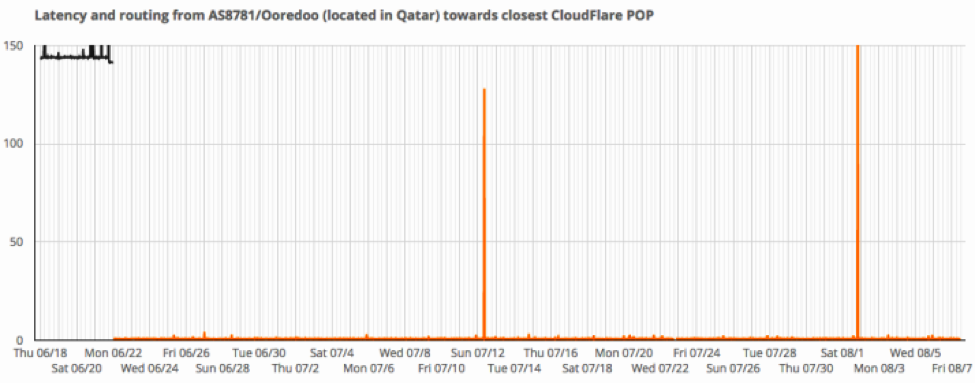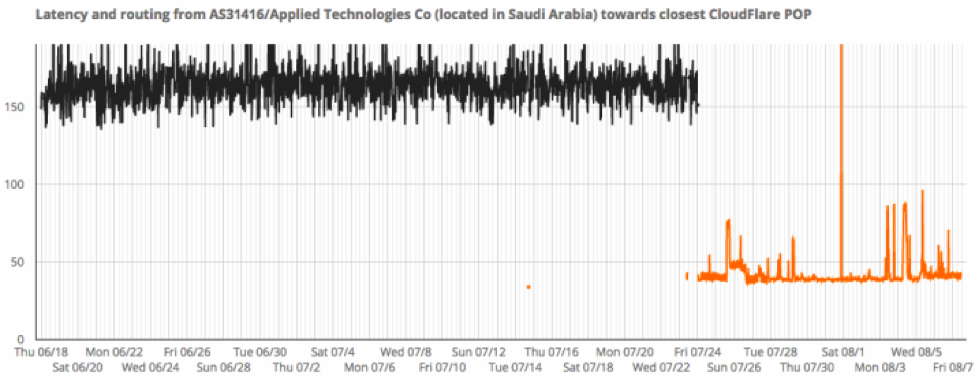
Our last embarkation into a new geography coincided with a significant milestone: our 30th data center (and first in Africa) in Johannesburg, South Africa. And as we march past number 40, we’re proud to announce yet another. Introducing CloudFlare’s latest points of presence (PoPs) in Doha, Qatar; Dubai, United Arab Emirates; Kuwait City, Kuwait; and Muscat, Oman. These data centers are the first wave in our MENA (Middle East/North Africa) expansion, and the 39th, 40th, 41st and 42nd data centers, respectively, to join our global network.
Up to this point all CloudFlare traffic delivered to the MENA region was served from our London, Frankfurt, Marseille, Paris and/or Singapore data centers, with round trip latency of up to 200-350ms. As in Africa, local bandwidth in MENA is notoriously expensive making it cost prohibitive to deliver content locally. That is (once again), until now! We're proud to announce the first of a series of agreements with regional carriers including Etisalat, Omantel, Ooredoo, and Zain to help build a better Internet in the region.

How to build a better Internet
A few of the necessary ingredients to build a better Internet include international connectivity (often in the form of submarine cable systems) that connect to national backbones which, in turn, deliver the Internet to the access networks that bridge the last mile to Internet users themselves—all of which must be in place and optimally utilized to meet increasing demand in the most cost effective way. Fortunately, in the MENA region, there is already good international connectivity, with the vast majority of Internet traffic transferred internationally through submarine cables (something we referenced in our Marseille blog post), and substantial investments already made into national backbones and last mile infrastructure (e.g. broadband and mobile networks) to the end user.

All MENA countries are connected with at least two submarine cables; the UAE alone has 15+!
The problem is that the international submarine cables built in the region were designed to link individual countries in MENA with Europe and Asia, and not to provide regional connectivity within MENA. The number of undersea cables that pass through the region without interconnection is staggering. Consequently, there is patchy submarine connectivity between the Middle Eastern parts and the North African parts of MENA (with Egypt playing a pivotal role). What this means for CloudFlare (and you) is that it takes a lot of individual PoPs to achieve broad, local coverage of broadband and mobile users in the region. It is for this reason that we’ve announced a record setting four new PoPs deployed in a single month, with even more on the way.
An additional complexity is that, even with all of the right infrastructure related ingredients, the majority of Internet content accessed in MENA is hosted far far away in North America, Europe and Asia. That is, of course, unless you are a CloudFlare user. As of now, the collective content of all 2 million+ CloudFlare users is locally accessible through the networks of our partners in the region. No additional configuration required. This re-routing of traffic is now automatically in effect for all CloudFlare users worldwide.
It's not a mirage
As the latency measurements below demonstrate, our data centers across the Middle East are already delivering significant performance improvement. In the United Arab Emirates, latency has decreased from as high as 200ms to the closest CloudFlare PoP to 10ms, a 20x improvement.

In Qatar (just in time for the upcoming World Cup) latency to Ooredoo (the incumbent operator) has decreased from 150ms to 1ms (a 150x improvement!).

The benefits also extend to some other countries and networks in the region. Latency to networks in Saudi Arabia, for example, have seen latency decline from 200-150ms to less than 50ms (a 4x improvement).

Source: Measurements from RIPE Atlas
As a whole, our first wave of MENA deployments serve traffic originating not only from Kuwait, Oman, Qatar, and the United Arab Emirates, but also traffic from networks in Saudi Arabia, Jordan, Iran, Pakistan and the Sudan, among others. Additional PoPs are in the works to expand and amplify these benefits throughout the region.
If you are curious about how this network expansion can help your organization, get in touch with our team.
P.S. No castle was touched within the deployment of these PoPs; keep guessing! We still don't have a winner in our contest announced here.
_Map source: Undersea Cable Map of the Middle East from Greg's Cable Map._

